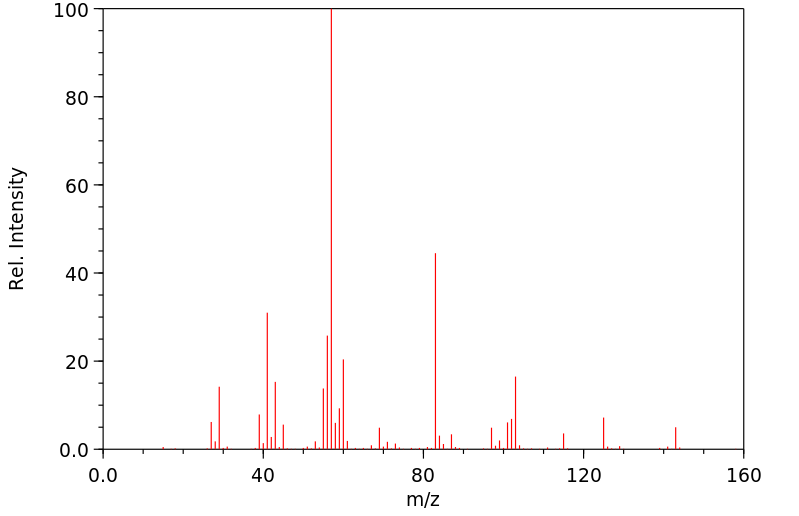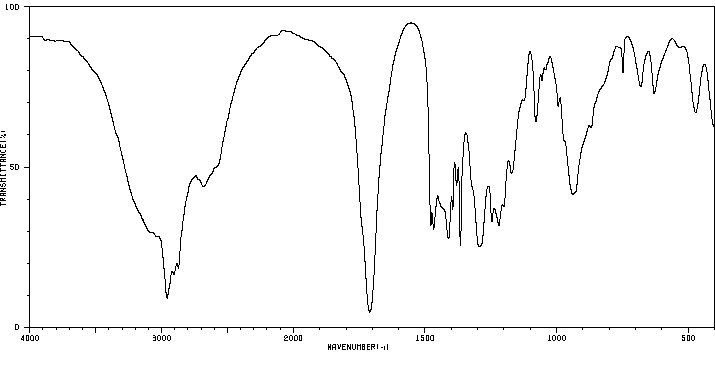3,3-dimethylheptanoic acid | 67061-30-7
中文名称
——
中文别名
——
英文名称
3,3-dimethylheptanoic acid
英文别名
——
CAS
67061-30-7
化学式
C9H18O2
mdl
——
分子量
158.241
InChiKey
KLRHFTOZNSFIHY-UHFFFAOYSA-N
BEILSTEIN
——
EINECS
——
-
物化性质
-
计算性质
-
ADMET
-
安全信息
-
SDS
-
制备方法与用途
-
上下游信息
-
文献信息
-
表征谱图
-
同类化合物
-
相关功能分类
-
相关结构分类
物化性质
-
沸点:140 °C(Press: 7 Torr)
-
密度:0.9059 g/cm3(Temp: 25 °C)
计算性质
-
辛醇/水分配系数(LogP):3.1
-
重原子数:11
-
可旋转键数:5
-
环数:0.0
-
sp3杂化的碳原子比例:0.89
-
拓扑面积:37.3
-
氢给体数:1
-
氢受体数:2
上下游信息
反应信息
-
作为反应物:描述:3,3-dimethylheptanoic acid 在 草酰氯 、 palladium on activated charcoal 、 氢气 、 N,N-二甲基甲酰胺 作用下, 以 甲醇 、 二氯甲烷 为溶剂, 40.0 ℃ 、506.66 kPa 条件下, 反应 4.0h, 生成 2-(hydroxymethyl)-2-methylpropane-1,3-diyl bis(3,3-dimethylheptanoate)参考文献:名称:[EN] IONIZABLE CATIONIC LIPIDS FOR RNA DELIVERY
[FR] LIPIDES CATIONIQUES IONISABLES POUR L'ACHEMINEMENT D'ARN摘要:本公开说明书描述了公式(I)的化合物及其药学上可接受的盐。公开号:WO2023086514A1 -
作为产物:描述:3-甲基-2-丁烯酸乙酯 在 copper(l) iodide 、 potassium hydroxide 作用下, 以 四氢呋喃 、 乙醇 、 水 为溶剂, 反应 2.0h, 生成 3,3-dimethylheptanoic acid参考文献:名称:酮衍生物和游离羧酸的远端 γ-C(sp3 )-H 烯化。摘要:本文报道了酮衍生物和游离羧酸的远端γ-C(sp 3 )-H烯化。微调先前报道的亚氨基酸导向基团并使用单N保护氨基酸(MPAA)和缺电子2-吡啶酮的配体组合对于γ-C(sp 3 )-H烯化至关重要酮底物。此外,MPAA 能够使游离羧酸发生 γ-C(sp 3 )-H 烯化反应,形成多种六元内酯。除了烷基羧酸之外,苄基 C(sp 3 )−H 键也可以通过 2-甲基苯甲酸衍生物一步功能化形成 3,4-二氢异香豆素结构。这些方案的实用性在大规模反应和 γ-C(sp 3 )−H 烯化产物的多样化中得到了证明。DOI:10.1002/anie.202003271
文献信息
-
A direct route to six and seven membered lactones <i>via</i> γ-C(sp<sup>3</sup>)–H activation: a simple protocol to build molecular complexity作者:Jayabrata Das、Pravas Dolui、Wajid Ali、Jyoti Prasad Biswas、Hediyala B. Chandrashekar、Gaurav Prakash、Debabrata MaitiDOI:10.1039/d0sc03144e日期:——Lactones comprise a class of valuable compounds having biological as well as industrial importance. Development of a methodology to synthesize such molecules directly from readily available materials such as aliphatic carboxylic acid is highly desirable. Herein, we have reported synthesis of δ-lactones and ε-lactones via selective γ-C(sp3)–H activation. The γ-C–H bond containing aliphatic carboxylic
-
Ligand‐Enabled γ‐C(sp <sup>3</sup> )−H Olefination of Free Carboxylic Acids作者:Kiron Kumar Ghosh、Alexander Uttry、Arup Mondal、Francesca Ghiringhelli、Philipp Wedi、Manuel GemmerenDOI:10.1002/anie.202002362日期:2020.7.27We report the ligand‐enabled C−H activation/olefination of free carboxylic acids in the γ‐position. Through an intramolecular Michael addition, δ‐lactones are obtained as products. Two distinct ligand classes are identified that enable the challenging palladium‐catalyzed activation of free carboxylic acids in the γ‐position. The developed protocol features a wide range of acid substrates and olefin
-
Direct β‐ and γ‐C(sp <sup>3</sup> )−H Alkynylation of Free Carboxylic Acids**作者:Francesca Ghiringhelli、Alexander Uttry、Kiron Kumar Ghosh、Manuel GemmerenDOI:10.1002/anie.202010784日期:2020.12.14palladium‐catalyzed C(sp3)−H activation that enables the direct alkynylation of free carboxylic acid substrates. In contrast to previous synthetic methods, no introduction/removal of an exogenous directing group is required. A broad scope of acids including both α‐quaternary and challenging α‐non‐quaternary can be used as substrates. Additionally, the alkynylation in the distal γ‐position is reported. Finally
-
Pd-Catalyzed Dual-γ-1,1-C(sp<sup>3</sup>)–H Activation of Free Aliphatic Acids with Allyl–O Moieties作者:Jayabrata Das、Tanay Pal、Wajid Ali、Sumeet Ranjan Sahoo、Debabrata MaitiDOI:10.1021/acscatal.2c02790日期:2022.9.16long-chain ones have been used as substrates in the protocol. A mechanistic investigation has been carried out and suggests C–H activation to be the rate-determining step and a subsequent allylic C–H activation in the reaction. The synthesized lactones having α,β-unsaturated fragments attached are expected to be useful in the synthesis of complex molecules via further synthetic manipulation.
-
REFRIGERATING MACHINE OIL AND WORKING FLUID COMPOSITION FOR REFRIGERATING MACHINES申请人:JX Nippon Oil & Energy Corporation公开号:EP2610329A1公开(公告)日:2013-07-03The refrigerating machine oil of the invention includes an ester of a polyhydric alcohol and a fatty acid, wherein the molar ratio of C4-C6 fatty acid and C7-C9 branched fatty acid in the fatty acid is between 15:85 and 90:10, the C4-C6 fatty acid includes 2-methylpropanoic acid, and the ratio of the total C4-C6 fatty acid and C7-C9 branched fatty acid in the total fatty acids composing the ester is at least 20 mol%. The working fluid composition for a refrigerating machine according to the invention comprises the refrigerating machine oil, a difluoromethane refrigerant and/or an unsaturated fluorinated hydrocarbon refrigerant.
表征谱图
-
氢谱1HNMR
-
质谱MS
-
碳谱13CNMR
-
红外IR
-
拉曼Raman
-
峰位数据
-
峰位匹配
-
表征信息
同类化合物
(±)17,18-二HETE
(±)-辛酰肉碱氯化物
(Z)-5-辛烯甲酯
(Z)-4-辛烯酸
(R)-甲羟戊酸锂盐
(R)-普鲁前列素,游离酸
(R,R)-半乳糖苷
(E)-4-庚烯酸
(E)-4-壬烯酸
(E)-4-十一烯酸
(9Z,12E)-十八烷二烯酸甲酯
(6E)-8-甲基--6-壬烯酸甲基酯-d3
(3R,6S)-rel-8-[2-(3-呋喃基)-1,3-二氧戊环-2-基]-3-羟基-2,6-二甲基-4-辛酮
龙胆二糖
黑曲霉二糖
黄质霉素
麦芽酮糖一水合物
麦芽糖醇
麦芽糖酸
麦芽糖基蔗糖
麦芽糖一水合物
麦芽糖
鳄梨油酸乙酯
鲸蜡醇蓖麻油酸酯
鲸蜡醇油酸酯
鲸蜡硬脂醇硬脂酸酯
鲸蜡烯酸脂
鲸蜡基花生醇
鲫鱼酸
鲁比前列素
鲁比前列素
高级烷基C16-18-醇
高甲羟戊酸
高效氯氰菊酯
高-gamma-亚油酸
马来酸烯丙酯
马来酸氢异丙酯
马来酸氢异丁酯
马来酸氢丙酯
马来酸氢1-[2-(2-羟基乙氧基)乙基]酯
马来酸单乙酯
马来酸单丁酯
马来酸二辛酯
马来酸二癸酯
马来酸二甲酯
马来酸二烯丙酯
马来酸二正丙酯
马来酸二戊基酯
马来酸二异壬酯
马来酸二异丙酯








